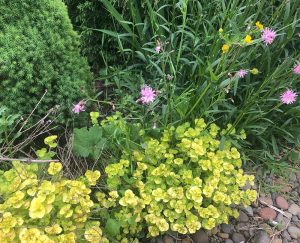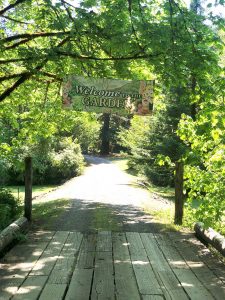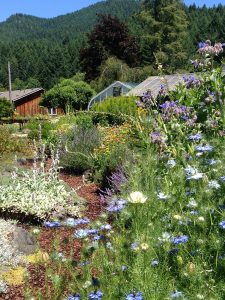
The other day, I joined my grandchildren’s outdoor school class as they visited a nearby, but remote, Oregon nursery, The Thyme Garden. To get there necessitated an hour-and-a-half car trip, part of it on roads that twisted over the side of Marys Peak, the tallest mountain in the Coast Range of the Siuslaw National Forest. But it was worth the drive.

This jewel of a family-owned nursery sells mail-order seeds of so many herbs and uncommon flowers that I was overcome for choice. As well as individual seeds packets, they feature collections, such as Healing Garden Herbs, Dye Garden Herbs, or Edible Flowers. Add to that more than thirty kinds of hops grown on their eighty-acre property. Hops (Humulus lupulus) are perennial in much of the U.S., and these fast-growing (up to twenty-five feet) vigorous vines are particularly useful, not only for making beer, but providing temporary shade as a cooling summer cover over a greenhouse.
Bethany Glanville, second-generation co-owner with her sister, Emily Stinac, showed the children and grownups how they sow their seeds in flats, many of them started early under cover. She took us through initial sowing, and then potting up, to demonstrate the way they bring their plants along.

The Thyme Garden also has a fine selection of herbs in containers—I had been looking for Brunnera ‘Alexander’s Great’ and found a gallon can on one of the tables. Other parents must have spotted plants they needed too, because the purchase line was long, while the children explored the pathways in gardens, the lush hedgerows, rustic gazebo, and swoops of mixed lawns, just right for running around. One parent said, “This would be a terrific summer camp.”
Here are suggestions for herbs that can be easily started in the greenhouse, and then gradually acclimated to outdoors. Remember that even though it seems strong, sunshine through glass is not the same as direct sun, so gradually introduce your seedlings to the outdoors by giving them longer hours of sun slowly. Their cells need to adjust to the brighter light. It can take up to three weeks for a full adjustment, but it’s worth the extra effort not to sunburn them.


Parsley – Petroselinum crispum (curly) and P. crispum ‘Neopolitanum’ (flat-leaf) – Both of these are slow to germinate—up to a month —so start early in a cool greenhouse. Check the trays for consistent moisture. Zones 5-10
Oregano – Origanum hirtum (Greek oregano) and Origanum spp. (mixed ornamental oregano) – The culinary Greek oregano has a stronger flavor than the species so it’s excellent for many dishes. And the golden ornamental oregano is a fixture in any garden, returning yearly to brighten pathway edges in full sun. Zones 5-10
Basil – Ocimum basilicum spp. and cvs. – The Thyme Garden offers twenty-seven different basils. Consider O.b.‘Amethyst’ (black-leafed basil); Baja basil; ‘Red Freddy’; or Minette (miniature basil). Sow every three weeks for the longest run throughout the growing season because when basil blooms, the leaves tend to lose their lush flavor. A warm greenhouse jumpstarts the earliest plantings. Later you can sow directly into the garden.

Bonus basil: Grow the tender O. gratissimum (tree basil) in your greenhouse year-round. In a large container it can reach seven feet with clove-scented leaves and yellow blossoms.


